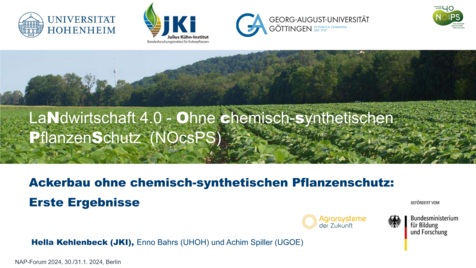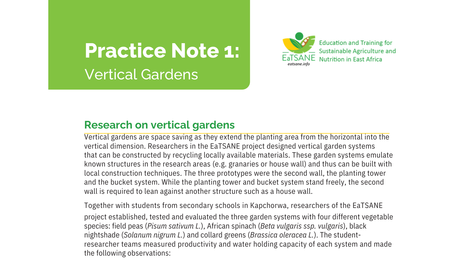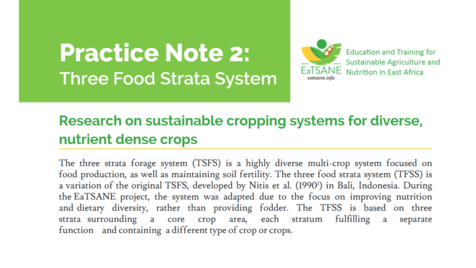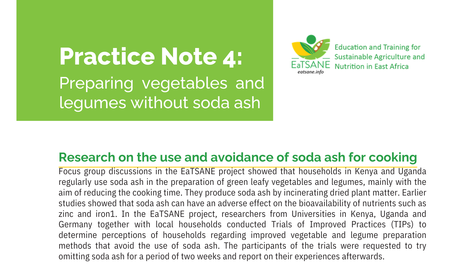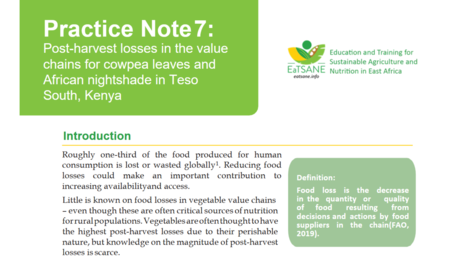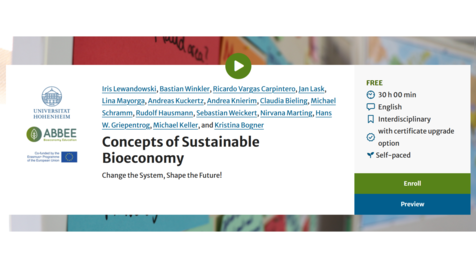Higher Education
Die wichtigsten Ergebnisse von LEX4BIO in Kürze
Das Projekt LEX4BIO forscht an der Optimierung biobasierter Düngemittel in der Landwirtschaft und stellt eine Wissensgrundlage für neue Richtlinien bereit.
Quelle: LEX4BIO Project (lex4bio.eu)
Forschungsprojekt Agrophotovoltaik
Agrophotovoltaik erhöht somit die Flächeneffizienz und ermöglicht die Ausweitung von Photovoltaik bei gleichzeitiger Erhaltung landwirtschaftlicher Flächen.
MIDAS-Agroforstwirtschaft am CREA IT
Das Video zeigt das Agroforst-Demonstrationsgelände des MIDAS-Projekts bei CREA-IT in Monterotondo (Rom). Hier werden Industriepflanzen in einem innovativen Agroforstsystem angebaut.
Entwicklung eines unterirdischen Wasserrückhaltesystems
Das Projekt MIDAS befasst sich unter anderem mit der Entwicklung von unterirdischen Wasserrückhaltesystemen, um den Wasserbedarf innovativer Anbausysteme von Industriepflanzen zu decken.
Ausarbeitung eines Geschäftsplans
Dies ist das zweite Video einer Tutorial-Reihe über nachhaltige und zirkuläre Geschäftsmodelle für biobasierte Wertschöpfungsketten. Es bietet eine Einführung in die Grundlagen der Erstellung eines Geschäftsplans.
Macauba-Palme und Mikroben als Ölquellen der Zukunft?
Das biotechnologisch hergestellte Hefeöl aus der Macauba-Palme ist chemisch identisch mit Palmöl und kann auf kleinstem Raum hocheffizient produziert werden.
Acrocomia research at the University of Hohenheim
At the University of Hohenheim, experts from various fields interact within the framework of collaborative approaches aimed at developing sustainable bio-based value chains, as is the case with Acrocomia.
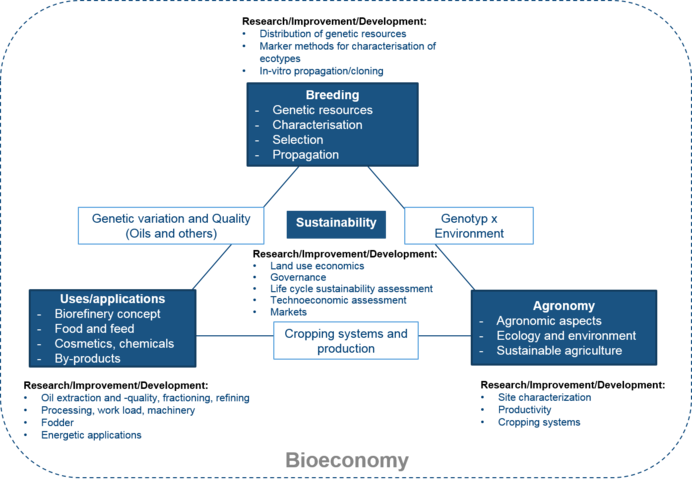 Source: Hohenheim Research Center for Global Food Security and Ecosystems (GFE)
Source: Hohenheim Research Center for Global Food Security and Ecosystems (GFE)Value Chains
As part of the GRACE project, ten bio-based value chains were demonstrated on an industry-relevant scale and innovative bio-based products were developed.
Bioeconomy - Shaping the Transition to a Sustainable, Biobased Economy | This book defines the new field of "Bioeconomy" as the sustainable and innovative use of biomass and biological knowledge to provide food, feed, industrial products, bioenergy and ecological services. The chapters highlight the importance of bioeconomy-related concepts in public, scientific, and political discourse. Using an interdisciplinary approach, the authors outline the dimensions of the bioeconomy as a means of achieving sustainability. | https://link.springer.com/book/10.1007/978-3-319-68152-8 |
| The effect of combined drought and trace metal elements stress on the physiological response of three Miscanthus hybrids | Drought is a serious threat worldwide and has a significant impact on agricultural production and soil health. It can pose an even greater threat when it involves land contaminated with trace metal element (TMEs). To prevent desertification, such land should be properly managed and growing Miscanthus for energy or raw material purposes could be a solution. | https://www.nature.com/articles/s41598-023-37564-5 |
| Prospects of crambe for the bioeconomy of the Swabian Alb in southwest Germany | The study focuses on rural regions characterized by marginal, flat, and stony soils, making them ideal candidates for researching the cultivation of resilient crops such as krambe. It examines the opportunities and challenges of growing and processing krambe in this specific region. | https://www.midas-bioeconomy.eu/wp-content/uploads/2024/07/Prospects-of-crambe-for-the-bioeconomy-of-the-Swabian-Alb-in-South-West-Germany.pdf |
| Profile and accumulation of essential oils from guayule (Parthenium argentatum A. Gray) accessions and hybrids | In a recent study published in the journal "Industrial Crops and Products", MIDAS researchers from the University of Castilla-La Mancha (UCLM), ITAP, and CIEMAT have uncovered the untapped potential of guayule (Parthenium argentatum A. Gray) as a source of valuable essential oils. Guayule, a shrub native to the Chihuahua Desert, is best known for its rubber and resin production. | https://www.midas-bioeconomy.eu/wp-content/uploads/2024/06/2024_INDCRO_118419_Profile-and-accumulation-of-EOs-1.pdf |
| A Collaborative, Systems Approach for the Development of Biomass-Based Value Webs: The Case of the Acrocomia Palm | The development of sustainability-oriented, biomass-based value chains from novel crops such as Acrocomia is a complex process that requires collaborative system approaches in research and development. This article examines the consideration of a system approach for the research and development of Acrocomia against the backdrop of the biomass-based value chain. | https://www.mdpi.com/2073-445X/11/10/1748 |
| Acrocomia spp.: neglected crop, ballyhooed multipurpose palm or fit for the bioeconomy? A review | Acrocomia spp., a genus of wild-growing palms in the neotropics, is rapidly gaining interest as a promising multipurpose crop. Diverse products can be derived from various components of the palm, the oils being of highest interest. | https://link.springer.com/article/10.1007/s13593-021-00729-5 |
| Vitamin E profiles in Acrocomia aculeata from three regions in Costa Rica | Acrocomia aculeata is a promising crop for agroforestry systems in subtropical regions and investigated as an alternative to oil palm. Since significant regional differences in morphology and chemical composition have been reported for Acrocomia fruits, the scientists aimed to determine the vitamin E profiles of Costa Rican Acrocomia aculeata from three different regions. | https://www.sciencedirect.com/science/article/pii/S0889157521001368 |
| Acrocomia aculeata fruits from three regions in Costa Rica: an assessment of biometric parameters, oil content and oil fatty acid composition to evaluate industrial potential | Due to increased global demand for vegetable oils, diversification of the supply chain with sustainable sources is necessary. Acrocomia aculeata has recently gained attention as a multi-purpose, sustainable crop for oil production. However, the information necessary for effective selection of promising varieties for agricultural production is lacking. The aim of this study was to assess variability in fruit morphology and oil composition of individual Acrocomia aculeata plants growing wild in different climatic regions of Costa Rica. | https://link.springer.com/article/10.1007/s10457-020-00511-8 |
| Biometric variability of inflorescence and flower traits among ex situ accessions of the neotropical oilseed palm Acrocomia Mart | The oilseed palm genus Acrocomia is suitable for sustainable oil production in South America. The high phenotypic diversity of wild populations poses a challenge for the delimitation of the genus. Comparing the inflorescence architecture, a first-order panicle, and staminate and pistillate flower traits could be a valuable tool in resolving the taxonomic disarray. Thus, this study aims to characterize the differences in the inflorescence architecture and floral structures of three common and economically significant Acrocomia species. | https://onlinelibrary.wiley.com/doi/full/10.1002/ece3.70053 |
| Phenotypic characterization and genetic diversity of macauba (Acrocomia aculeata) accessions based on oil attributes and fruit biometrics | Macauba is a Brazilian native palm whose fruits have a great economic potential, due to the presence of oil in the pulp and kernel, which can be used by biofuel, cosmetic and food companies. The study of its genetic variability paves the way for the pre-breeding of the palm tree. In this context, the present work aimed to evaluate the genetic variability in macauba genotypes from different Brazilian locations. | https://link.springer.com/article/10.1007/s10722-024-01856-0 |
| Sustainable strategies: Nature-based solutions to tackle antibiotic resistance gene proliferation and improve agricultural productivity and soil quality | The issue of antibiotic resistance is now recognized by the World Health Organisation (WHO) as one of the major problems in human health. Although its effects are evident in the healthcare settings, the root cause should be traced back to the One Health link, extending from animals to the environment. In fact, the use of organic fertilizers in agroecosystems represents one, if not the primary, cause of the introduction of antibiotics and antibiotic-resistant bacteria into the soil. | https://www.sciencedirect.com/science/article/pii/S0013935124002998 |






